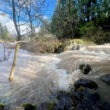Alex Paul
Although government officials are concerned, they haven’t reached the panic stage concerning the lack of winter precipitation and snowpack in the Willamette Valley and throughout much of Oregon as a whole.
The Sweet Home area has received only 1.85 inches of rainfall through January, well below normal, according to Corps of Engineer records at Foster Dam.
But, most officials say Oregon weather is fickle and while the lack of snowfall has had a direct impact on ski lodges, with facilities such as HooDoo closing for a while last week, spring rains could quickly ease drought worries.
State Climatologist George Taylor said his biggest concern is the lack of snowpack.
“We’re only about 30 percent of normal and that’s not good,” Taylor said. “The good news is that spring rains are the next best thing and the truth is, the later in the spring we get it, the better it will be in terms of agriculture and the forest.”
Those late spring rains offer better subsoil moisture retention for farmers and keep pastures alive longer into the summer months such as July and August, which are typically extremely dry in Oregon.
Taylor said the Corvallis area received 12.08 inches of rain from October to January. That’s compared to the least rainfall for that same period in 1977, which was just 5.1 inches.
The average for that period is 23.85 inches.
“The area reservoirs, rives and agriculture will have to depend now on what happens this spring,” Taylor said. “One inch of rain in April can be like three inches in November.”
Cindy Henriksen, Chief Reservoir Control Officer for the Corps of Engineers in Portland, echoed Taylor’s sentiments.
“The Willamette Valley is different from the Columbia region in that the Valley doesn’t depend quite as much on snowpack,” Henriksen said. “The Columbia region depends quite a bit on snowpack that extends into the Canadian Rockies.”
Henriksen emphasized, “It’s still early…we could get a wet spring.”




